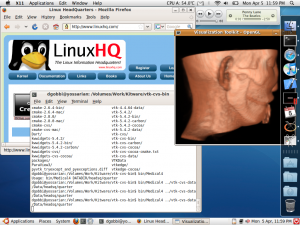This article is about my adventures in getting Linux to run on the OS X desktop. Usually Parallels and VMWare only allow the Linux virtual machine to run fullscreen or in a window, in contrast to they way they allow Windows to share the OS X desktop in their "Coherence" and "Fusion" modes.
Fortunately, by using X11 on OS X and XDMCP on Linux it is possible for Linux to use the OS X desktop as if it was its own, and with virtually no loss of performance. I also discovered other tricks along the way, for instance the OS X nfs server is much faster than Parallels' shared file system. The instructions are too long for a news post, so I have set up a wiki page for them.
When I purchased my MacBook back in October 2009, my very first action was to load Windows and Linux on it. Linux because it has been my day-to-day operating system for years, and Windows because it is a necessary evil for financial software and the like. A magical piece of software called rEFIt allows me to choose an operating system at boot time, and a shared "Work" partition keeps all my code available to both Linux and OS X.
So, with Parallels, I chose to run my virtual machines directly off the Windows and Linux partitions. This is how I have always created virtual machines. It's a fair bit more work than using a virtual drive, but I always like to know that I can boot the partitions directly if I have to. And it is, in fact, irrelevant to the topic at hand: getting Linux to share the OS X desktop works identically regardless of how the virtual machine has been set up.

